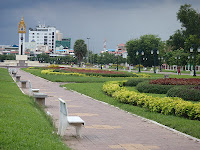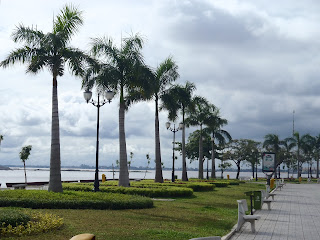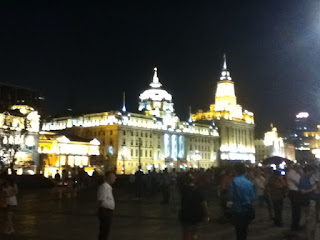The remainder of my China trip was a whirlwind of one city to another, via trains and buses, with a mission in each place to get a new set of maps, go charging off after the next place, get terribly lost and formulate a new plan as I went along, then recover in cafes. I loved it. Instead of going through them one by one, I’ll just hit some highlights of each place I went after Beijing – reading through them quickly will probably give you a better sense of just how fast the time went by to me.
Shanghai
My time in Shanghai was greatly enhanced by having a lovely host, Megan, who put me up after knowing me for about six hours total. We met in April at a concert in Seoul, for which she flew in from Shanghai to see with Katie, our mutual friend who had also invited me. I told Megan that I was planning to travel to Shanghai this fall, and she graciously invited me to stay with her whenever I made it down there. I was so glad I took her up on it – to have home comforts like eating popcorn while watching TV on a cozy sofa is even better when you’re on the road, and Shanghai couldn’t have come at a better time – I was worn out from Xian and Beijing.
 |
| The French Concession |
After Megan finished work she took me up to her fantastic apartment, right in the French Concession, and then after I showered and dumped my stuff, we went out for a delicious Schezuan dinner and caught up. She has lived in Shanghai for nearly four years now, and had some fantastic insight into living in China as an expat. After a luxurious sleep in her guest room, I got up the next day and hit the streets for a full day of walking around, seeing the best of Shanghai while Megan went to work.
Shanghai = architecture. From the European style houses in the French Concession to the weird, moderny art-y new buildings, to the Art-Deco 1920s buildings of the Bund, to (not done yet) the futuristic skyscrapers and weird looking rocket ship thing of Pudang (below left), and even to traditional Chinese architecture…Shanghai has it all. So many buildings, so much foreign influence, so much fun to see. I spent the whole day walking across the city, and decided that my favorite part was the Bund (below right). Read more about it
here.
Lucky for me, the Bund was even more beautiful at night that during the day. Megan took me to a rooftop bar overlooking the Pudang skyline, while viewing the Bund from the top. It couldn’t have been a more perfect last evening in Shanghai, and I decided it was my favorite city in China thus far.
Guilin
Guilin was a last minute change in my itinerary. I was originally planing to go to Nanjing, but after three big cities in a row, soon to be a fourth, I decided against it, and instead made my way south to Guangzhou (where my flight was from to get me to Thailand) via Guilin. Gulin and its surrounding area’s claim to fame is its karst topography, the little green mountains that kind of look like giant thumbs sticking up from the ground.You can see just a hit of one of them in the background of the photo. If you’ve ever seen the recent movie The Painted Veil, starring Naomi Watts; you've seen some of Guilin.


I knew I only had limited time, and I hadn’t done any research prior to leaving, so my plan was just to enjoy what scenery was close by and relax. Luckily, I found a hostel close to the river, the same river I remember reading about in my mom’s journal, so I ventured out there for a lovely evening sunset walk. There isn’t much karst topography that you can see without taking a trip outside of Guilin, so I didn’t get the beautiful images that you see in postcards (see right, from Google Images.) However, just being out in the country, with quiet streets and small buildings, was enough for me. I had spent some time gazing out at the Chinese countryside from the train window that morning (pictured below), and now I finally felt as though I was seeing more of ‘real China’ instead of just big cities. The sunset and night market were a fun way to end the evening and my time in the countryside.
Guangzhou
I spent approximately 20 hours in Guangzhou, formerly known as Canton, and most of it was spent wandering around in a foggy, sleep deprived haze, as my night bus came in 4 hours earlier than I expected it to. It turned out when the ticket lady said “eight” when I asked what time I would arrive Tuesday morning…she meant I would arrive after eight hours instead of at eight in the morning. I had left Guilin at 8:30 the previous night. You do the math.

Nevertheless, I had a fully day to occupy myself until I flew to Bangkok on a redeye that night. My first stop? Dim sum for breakfast. I joined a cute little crowd of old people (see them all lining up at the entrance, ready for the 7 am door opening?) who apparently were regulars, and sat down with their newspapers, while having their tea poured and prepared for them. I had no idea how to order or what to do, so I just watched for a little while, then I figured it out. Here's how you do it: traditionally I think they roll it around in carts and you just pick these little basket/plate things that you want to eat. This restaurant's style was more buffet-type, but you have to wait for them to bring out a fresh batch of something, then swarm. Yes, swarm. Another reason I patiently waited and observed instead of fought old ladies for some steamed buns - no one wants to see that fight since they would probably win. But, I was successful in the end by waiting it out. They mark your little paper you carry around with you so that they know what you've taken, then you go back and enjoy, pay later. Dim sum and soup for breakfast – yum.

After dim sum I took a walk around and ended up on Saimen Island, which is an ‘island’ approximately 2 meters from the mainland that you ‘cross over to’ on a footbridge. I discovered that it used to be the British and American concession during Canton’s heydays, which made for cute streets, a nice little park, pretty buildings, and, always my godsend, a Starbucks.
Normally I’d love to include a top ten list about my travels in China, but as time is pressing for me to board my plane to Bangkok, I decided I’d hit on the top five cultural elements of China that had the greatest impact on me. You read about what I did and saw, now here’s more on how I felt during my two week trip:
1. The people. Chinese people are sassy. They’re not afraid to let you have it, to be rude to you, or to cheat you blind. By ‘you’ I refer to any touristy-looking-foreigner they come into contact with - not hard to find in any given city in China. But please don’t get me wrong – though there were a few encounters with not-so-helpful people, my overall impression was that Chinese people are friendly, kind, and helpful. I always got to where I needed to go or received whatever help I needed when I asked.
My first encounter with a Chinese person was on the plane, when I sat next to this cute little old lady who was fascinated with my illegible scribble that I was writing in my journal. She didn’t hide her curiousity, nor was she bothered by the fact that I didn’t speak a lick of Chinese. I took out my iPod to show her Google Earth’s map and demonstrate that I was from America, but I was a teacher in Korea. I don’t think comprehension was registered, but she had lots of fun spinning the little digital globe with a swipe of her finger. She showed her enjoyment by continuously prodding me for the remainder of the flight, just to smile at me when I looked up, and motioning for me to write my name on the barf bag. Chinese people are great. They get an A.
 |
| He decided to photobomb and enhance my picture at T-Square... he made it better. |
2. The food. China Wok or Panda Express have nothing on authentic Chinese food. From my first bite of greasy street food to a simple, home cooked meal in the hostel kitchen, my mouth was happy with every bite. It’s cheap, it’s easy to grab on the go or easy to find a quick place to sit down and enjoy a meal. China is similar to Korea in this way, but I found a much wider variety of food that changed with each region I visited. The north has much heartier meals, such as dark, beef sauces with thick breads, while the south is much more rice, sweet sauce, and vegetable oriented. Just as in India, I enjoyed eating my way through China immensely.
 |
| Don't worry, I mostly stuck with noodles and rice. |
3. The beauty. The word ‘China’ usually evokes misty mountains, peaceful pagodas, and crazy flexible people practicing tai chi. Cut to a busy city street with bikes, motorcycles, cars, and buses. It’s all there, but more often than not, you can find little pockets of beauty wherever you go. Little statues, random gardens, and people practicing tai chi or playing shuttlecock in public parks in the morning were all to be found if you knew where to look, or if you were just horribly lost and stumbled upon things, like I usually was. Evidence of China’s glorious past is still manifested in the rooftops, quiet neighborhoods, temple buildings, housing structures, and of course, monuments. And for the more musically inclined, there were many instances where I walked through quiet neighborhoods and heard a CD or radio playing traditional Chinese tunes, just for a little mood music. China has always been a proponent of beautiful culture, and their heritage lasts to this day, as they find their place (at the top, it seems) in the modern world.

Okay, so that was it for the good. Let’s get a little ugly and turn the tables on China: two notes on things I didn’t particularly enjoy:
4. Something has to be said about Chinese bathrooms. I dealt with some pretty gross ones in India, but for some reason Chinese bathrooms just have this bright neon warning sign in my head – you can tell whenever you’re near one because you will smell urine. Not inside the toilet, like it’s supposed to be, but likely somewhere on the floor nearby the squatter where somebody missed. And then you have pee on your shoes.
I was a very pro-active bathroom seeker – I planned my liquid consumption accordingly to when nature should call at an appropriate time, preferably when I was in a coffee shop, my hostels, or near a shopping mall. I was actually surprised at the number of Western toilets in places like shopping malls and even the train station, occasionally. I have nothing against squatters, and perfected my technique while living in Korea, but for some reason the pervasive smell of Chinese bathrooms haunted me the whole time I was there – especially when I was on a night train. No way out. By the end of my two weeks I thought I had escaped the worst of it, as I only encountered varying degrees of metal and porcelain squatters, a far cry from the wooden troughs my mom described to me from her trip only thirty years earlier. But, as fate would have it, in its true desire to provide me with the full Chinese experience: on my last night in China during a rest stop on the overnight bus, I encountered not only a wooden trough bathroom, but one without stall doors. That topped it all. I did not include a picture of a Chinese bathroom.
5. And for my final cultural insight into China, I leave you with a question: How do you cross a street in China? Sound like a pretty simple question, right? Well, the answer is just as simple. Have you ever played Frogger? It’s like that.
For those of you who don’t know what Gameboy game I’m referring to, it’s the one where you cross (is it ponds?) on lilypads, but you have to go one ‘lane’ at a time and then dash out when there’s a break between you and whatever it is that could potentially kill you, which is coming at you in a steady, unstopping stream. This is how you cross the street in China – the lights have no significance whatsoever, unless you’re at a super busy intersection. And of course, what could potentially kill you includes cars, trucks, buses, motorscooters, bicycles, what have you. It’s a dangerous life, being a pedestrian in this country.
That concludes my top five for China. As I cleared the departures desk at immigration (still scary, even on the way out) and my time in China ended I reflected back as best I could in my foggy, sleep deprived state. I’ll miss the people, the food, the beauty, and my anonymity…but I won’t miss the bathrooms.
Next up: Adventures in Ko Chang, Thailand with fellow adventurer Sara Mowchan. Take care!

 My next excursion, with the girls, was equally as eye opening, but this time it was more 'hands on.' We went to the Cu Chi tunnels, about an hour outside the city, to tour part of the extensive, 200 km network of underground tunnels, built and used by the guerrilla Viet Cong troops to make their attacks against the Nationalist and American armies. There were traps, false tunnels, and hidden passageways all along the network, and it was eerie to be walking around in the very jungles where the war had taken place, 40 years before. It was real, it was scary, but it was good to see and to put things in perspective. We even got to crawl through the tunnels (what I meant by 'hands on,' quite literally) which was pretty claustrophobic.
My next excursion, with the girls, was equally as eye opening, but this time it was more 'hands on.' We went to the Cu Chi tunnels, about an hour outside the city, to tour part of the extensive, 200 km network of underground tunnels, built and used by the guerrilla Viet Cong troops to make their attacks against the Nationalist and American armies. There were traps, false tunnels, and hidden passageways all along the network, and it was eerie to be walking around in the very jungles where the war had taken place, 40 years before. It was real, it was scary, but it was good to see and to put things in perspective. We even got to crawl through the tunnels (what I meant by 'hands on,' quite literally) which was pretty claustrophobic. Hoi An was every tourist's dream town. It was cute, it was small, it was historical, it was easy to walk around in, it had nice, cheap, clean guesthouses and tons of delicious restaurants and cafes. There were boat rides, bicycle rentals, river strolls, spa treatments, and photo opps to be had. And don't even get me started on the shopping. I challenge you not to like Hoi An.
Hoi An was every tourist's dream town. It was cute, it was small, it was historical, it was easy to walk around in, it had nice, cheap, clean guesthouses and tons of delicious restaurants and cafes. There were boat rides, bicycle rentals, river strolls, spa treatments, and photo opps to be had. And don't even get me started on the shopping. I challenge you not to like Hoi An.



 We went kayaking, swimming, (until we saw some jellyfish hanging out by our kayaks) cave exploring, and hiking, in between sunbathing on our little balcony and relaxing on the boat between meals. The meals were fantastic, with a variety of seafood, vegetables, curries, rice, and fruits for dessert. After eating on the cheap for a month or so, we felt very spoiled with all our food.
We went kayaking, swimming, (until we saw some jellyfish hanging out by our kayaks) cave exploring, and hiking, in between sunbathing on our little balcony and relaxing on the boat between meals. The meals were fantastic, with a variety of seafood, vegetables, curries, rice, and fruits for dessert. After eating on the cheap for a month or so, we felt very spoiled with all our food. The girls decided to stay an extra night on one of the nearby islands, but I chose to head back to Hanoi the next day so that I could have some time to explore before hopping on a bus to Laos. So, last stop of Vietnam: Hanoi, the capital city.
The girls decided to stay an extra night on one of the nearby islands, but I chose to head back to Hanoi the next day so that I could have some time to explore before hopping on a bus to Laos. So, last stop of Vietnam: Hanoi, the capital city.















































